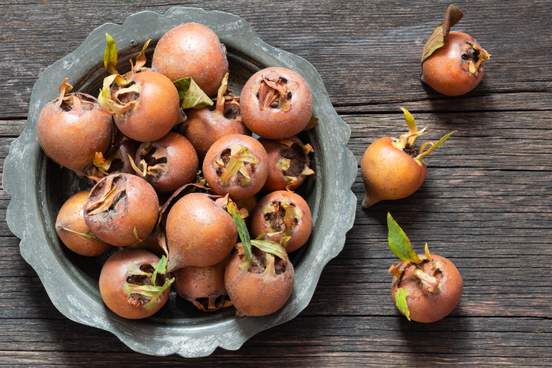
Medlar
: the crab apple-like fruit of a small deciduous Eurasian tree (Mespilus germanica) of the rose family
We’re going to level with you: “crab apple-like” is a very polite way to describe this quirky fruit. Over the centuries, what the Oxford English Dictionary refers to as its “gaping apex and persistent calyx-lobes” have led to the medlar being called by a host of less savory names that we will refrain from repeating here, thank you very much. But don’t let cheeky sobriquets take away your appetite—once properly softened (by frost or storage), medlars have a tart, apple-like flavor, perhaps unsurprising for a fellow member of the rose family. The word medlar traces back all the way to the Greek mespilon, used for the same fruit.
When ready to harvest, the golf-ball-size fruits resemble small apples, except … their calyx ends (opposite the stem ends) are flared open. This latter characteristic earned medlar the nickname “open-arse fruit” among medieval writers such as Chaucer.
— Lee Reich, Associated Press, 5 Nov. 2019
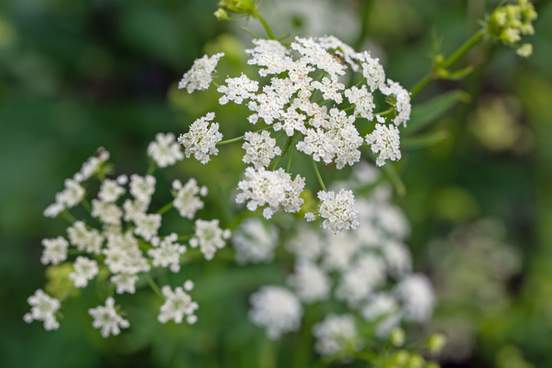
Skirret
: the sweet edible tuberous root of an Asian herb (Sium sisarum)
If you’re into roots, as well as the roots of roots, skirret’s tale is an interesting one. In a bit of folk etymology, Middle English users took the Middle French word for the carrot cousin, eschervi, and made it skirwhit, a combination of their own words skir (“bright”) and whit (“white”). Eschervi, in turn, is probably a modification of the Arabic word karawyā, used for both skirret and caraway.
Skirret (Sium sisarum) is a forgotten treasure from Tudor times. The plant forms a cluster of long, pencil-thick, white roots that can be a bit fiddly to clean, but they have a flavour somewhere between potatoes and parsnip, and were once considered the finest roots to eat. Skirret is best boiled, mashed or gently roasted (you’ll find many Tudor recipes for skirret pie).
— Alys Fowler, The Guardian (London, England), 10 June, 2017
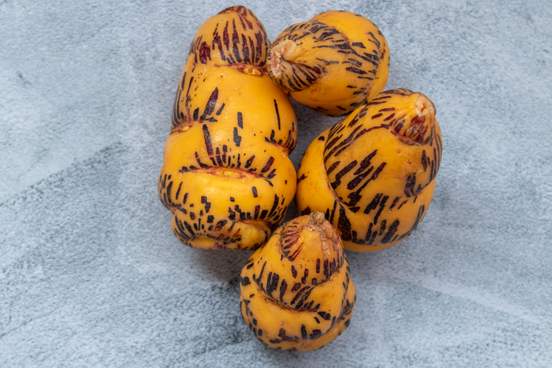
Oca
: the cultivated tuber of either of two South American wood sorrels (Oxalis crenata and O. tuberosa)
There are over 550 species of wood sorrel in the world; if you live within the range of a wood sorrel, chances are you’ve seen one, as they’re often considered weeds, growing rapidly and abundantly. Wood sorrel leaves are characteristically sour, some would even say lemony, as they contain oxalic acid, which is also found in spinach (wood-sorrel leaves should not be eaten in large quantities, accordingly). Oca refers to the tuber of two South American wood sorrels, and comes via Spanish from the Quechua word oqa. Oca tubers also contain varying degrees of oxalic acid, and range from sour to sweet in flavor, depending on the cultivar.
Corn is one of the most important crops in the Peruvian Andes, alongside potatoes and other tubers like oca. But Bhojwani never imagined he would meet someone who was making an oca wine, much less that someday he would be distilling it into oca brandy.
— Nico Vera, Whetstone Magazine, 24 Jan. 2022
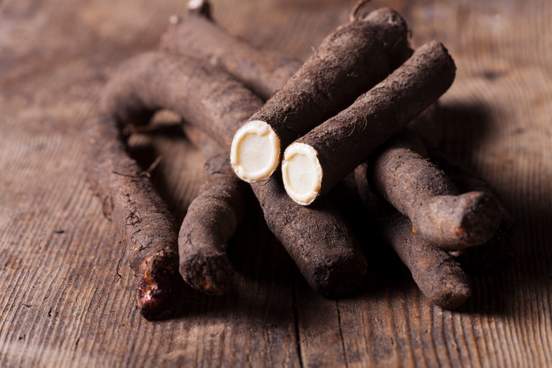
Salsify
: the long fusiform edible root of a European biennial composite herb (Tragopogon porrifolius)
We know, we know, salsify sounds like it should be a verb, as in “it’s time to salsify those tomatillos for the party.” But guess what? It is not. Salsify (the third syllable rhymes with glee) refers instead to the edible root of a wildflower that has also been known as the oyster plant or vegetable oyster, though opinions vary as to how oyster-like it tastes—we hear it is more reminiscent of artichoke hearts. Salsify comes from the French word salsifis, which in turn comes from Italian salsefica or sassefrica.
Having scraped the salsify roots, and washed them in cold water, parboil them. Then take them out, drain them, cut them into large pieces and fry them in butter. Salsify is frequently stewed slowly till quite tender, and then served up with melted butter. Or it may be first boiled, then grated, and made into cakes to be fried in butter.
— Eliza Leslie, Directions for Cookery, in Its Various Branches (Carey & Hart, 1840)
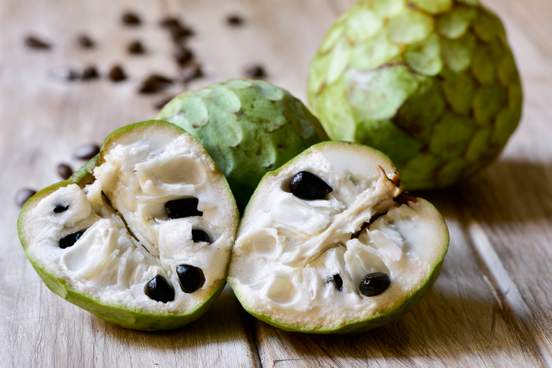
Cherimoya
: a round, oblong, or heart-shaped fruit with a pitted pale green rind that is borne by a widely cultivated tropical American tree (Annona cherimola) of the custard-apple family
Like oca, cherimoya is another Quechua borrowing via Spanish. Even if you’ve never tasted a cherimoya, one look at the cross-section of the fruit should make it clear why it is also sometimes called custard apple, as are its relatives, including the soursop and the pawpaw. The cherimoya’s flesh is creamy in texture, and like that of its cousins, tastes like a mixture of banana with other fruits.
The cherimoya looks like a leathery fat green pine-cone, but do not be fooled. The skin is easily broken. When you buy some, put them carefully on top of your basket. The larger fruits have a less firm look, and they are even more delicate.
— Jane Grigson, Jane Grigson’s Fruit Book (Atheneum, 1982)
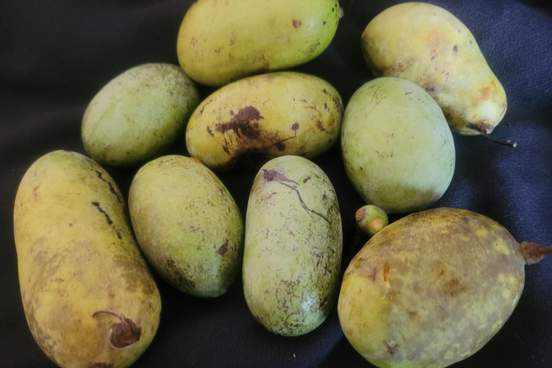
Pawpaw
: the edible green-skinned fruit of a purple-flowered North American tree (Asimina triloba) of the custard-apple family
Every year in late summer/early fall, the eastern third of the continental United States (and a touch of southern Canada) is all abuzz about pawpaws, the largest fruit native to North America. The origins of the word pawpaw aren’t crystal clear, but it’s probably a modification of the Spanish papaya. Like its custard apple cousins, the pawpaw has a smooth, creamy texture and a flavor reminiscent of a banana crossed with other fruits.
Pawpaws are a river fruit. They grow under many conditions and in many climates, but they’re most abundant and reliably found growing in the deep alluvial soil of American bottomlands, along creeks, streams, and great rivers from the mighty Mississippi to the Wabash, Susquehanna, Missouri, and Potomac.
— Andrew Moore, Pawpaw: In Search of America’s Forgotten Fruit (Chelsea Green, 2015)
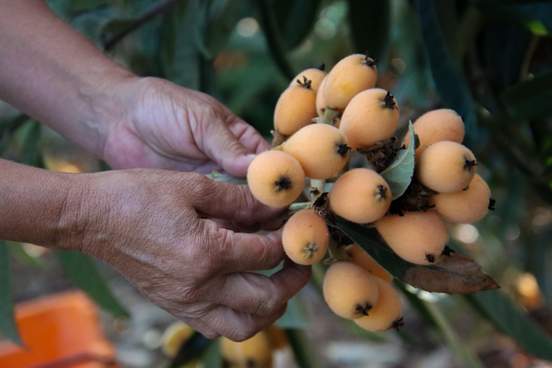
Loquat
: the small yellow edible fruit of an Asian evergreen tree (Eriobotrya japonica) of the rose family
Rosaceae, the rose family, has given the world many, many, many fruits, from the incredibly common (apples, pears, peaches, plums) to the lesser-known, including quinces and—at least in some parts of the world—loquats. Loquat comes làuh-gwāt, the word used for this diminutive fruit in Guangdong, China. High in pectin, loquats are often used to make jams and jellies.
Here the air blew across orange groves and came laden with the sweetness of opening buds; here, if it were a sunny Christmas Day, as well it might be, the children came in to dinner tired with playing in the garden: but the same sort of joyous cries that rent the air three thousand miles away at sight of hot plum pudding woke the echoes here because of fresh strawberries and loquats…
— Kate Douglas Wiggin, Marm Lisa (Houghton, Mifflin and Company, 1896)
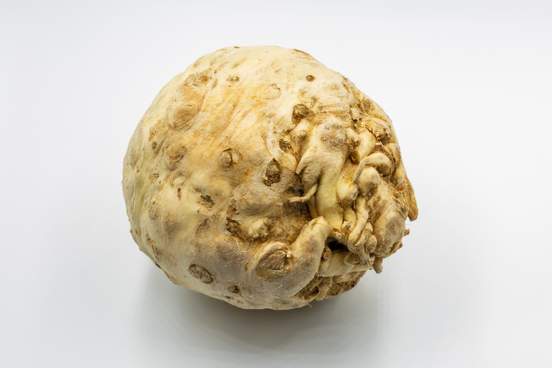
Celeriac
: the knobby edible root of a celery (Apium graveolens rapaceum)
Unlike loquats, the celeriac is decidedly not used to make jams and jellies, at least not that we’ve heard of or dared to try. This vegetable—the root of a variety of celery related to the one whose leafstalks are commonly eaten both raw and cooked—is more often roasted, pureed, and added to soups and stews. As you would expect, the word celeriac is an alteration of celery, though the origin of the suffixal -ac is obscure. Celeriac was apparently introduced by the English gardener and landscaper Stephen Switzer (1682?-1745) in A compendious, but more particular method, than has ever yet been published, for the raising Italian brocoli, Spanish cardoon, celeriac, fenochi, and other foreign kitchen vegetables, so as to make them dishes more generally used than hithero they have been (London, first edition 1728 or 1729). Switzer claimed to have received celeriac seeds from Alexandria, but gives no account of the source of the word.
Dr. Pakheiser went straight through the brandy and even then had not had enough to drink, so he replaced the empty decanter with the one half full of kümmel. He thought of the supper he soon would eat and he began to wonder what the Horvath family had upon their table. For some reason, he had an idea they were fond of mussels (which made him ill) and he was positive they enjoyed the displeasing flavor of celeriac in their soup. They would have chunks of fat meat; they would especially like rutabaga, watermelon, molasses, pancakes and hot tamales.
— Jean Stafford, The Interior Castle (Harcourt Brace, 1953)





